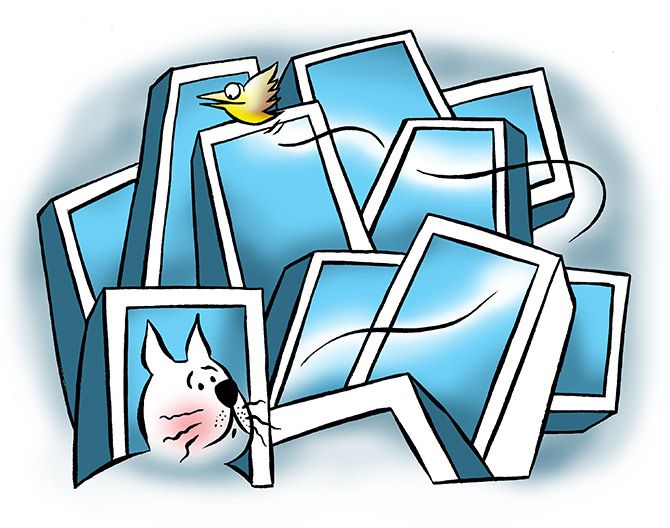 | « Back to article | Print this article |
Compared to a 64 per cent penetration in Brazil (130 million users total) and 53 per cent in China (total 733 million users), India has barely 28 per cent penetration.
Of the digital reach, almost 80 per cent are from affluent segments in urban areas.
How can this change?
Illustration: Uttam Ghosh/Rediff.com

India has it all, at least on paper. A digital stack endorsed by the government that helps technology companies provide unique digital solutions to the masses, dirt cheap data prices and a plethora of online retail and financial service providers tapping into the opportunity.
Yet, as a report by Bain and Company, Google and Omidyar Network titled ‘Unlocking digital for Bharat: $50 billion opportunity’ shows, millions are untouched by the internet, those who have access barely use it and a tiny group of 160 million consumers is transacting online.
So what is still holding back the country’s long promised digital revolution?
According to the report, India has the second-highest set of active internet users globally (around 390 million) and has seen the highest velocity of user addition (average 40 million added per year).
Further, mobile data usage (approximately 8 GB/subscriber/month) has reached the levels of developed markets, but these numbers tell just part of the story.
The data does not, for instance, reveal the poor levels of penetration, or draw the red lines around the low transaction levels online.
Compared to a 64 per cent penetration in Brazil (130 million users total) and 53 per cent in China (total 733 million users), India has barely 28 per cent penetration.
Of the digital reach, almost 80 per cent are from affluent segments in urban areas.
Anand Jain, COO and co-founder of CleverTap, a digital marketing firm notes that brands in India are evolving towards a business model that also enables digital transactions.
The numbers dished out on reach and the growing time spent by Indians online hold brands in thrall.
Jain believes that brands that want to maximise their digital potential must work on enhancing trust and transparency.
“Taking a cue from the introduction of Cash on Delivery (CoD), which was one of the earliest approaches to building trust, brands should now proactively educate users about data privacy, and security of their transactions,” he said.
Brands seem to have taken note and hence the introduction of hassle-free returns and refunds; engagement of multiple payment options, UPI payments and mobile wallet integration are growing too.
But lack of transparency and awareness are still huge bottlenecks, Jain added.
Users don’t completely trust online channels and thus continue to drop out of transactions even after spending hours browsing and discovering websites.
Out of 390 million active internet users barely 40 per cent transact online and a third of that number doesn’t go beyond their first purchase.
Quite often the experience online is marred by sudden changes in price, opaque product details or failure to keep to the delivery schedule.
“Digital India is at a very interesting point -- a large internet user base with significant variations across demographics, and only a small portion actually transacting online.
"While online spends are still low given lower per capita incomes, there is huge potential to unlock value by addressing user concerns at various stages of the digital curve; however, the path won’t be easy for businesses and they will have to innovate and be patient to monetise this user base and generate value,” said Arpan Sheth, partner, Bain & Company, co-author of the report.
So how can penetration and online spending improve?
Among the suggestions of this report is a large need for public-private partnerships to create more access and awareness among the masses.
Currently there are multiple grassroots level programmes like Google’s Internet Saathi programme and Vodafone for Business which help engage communities beyond big cities into the internet ecosystem.
Also expected to change the penetration and usage patterns is the government’s BharatNet initiative that plans to enable internet connectivity among gram panchayats in the country.
Meanwhile, brands are pinning their hopes on the promised digital potential of the Indian market. But the question is: how long will hope trump reality?
| Reality check |
|
User base is skewed, not equitable across socio-economic classes: Of the 390 million internet users, 80 per cent (300 million) are from relatively affluent NCCS segment A, B, and C alone A mere 13 per cent internet penetration across lower-income segments (just 90 million users in a base of 710 million) versus 73 per cent across NCCS segment A Transacting user base is small: Of the 390 million users, only 40 per cent (160 million) transact online Transacting base skewed as well: 90 per cent transactors (140 million out of 160 million) from NCCS segments A, B, and C Balance 60 per cent of users (230 million) go online for product research and content but prefer offline channel for transactions Large unlock possible by enabling online transactions for a broader user base Stay with the user: Typical users take 3–4 months from internet usage to first transaction, brands must learn to engage with them during this period Build relevant content: Important to help users understand the purchase process through relevant content and use cases. Build familiarity: Trust in channel increases as more time spent on Internet. Among users who have been on the internet for two or more years, 61 per cent transact online. The number is just 27 per cent among new users Control dropouts: 54 million users, across NCCS segments A, B, C alone, stop online transaction post first trial purchase. Critical to re-engage with the journey dropouts to increase transacting user base Source: Unlocking digital for Bharat: $ 50 billion opportunity, Bain and Company, Google, Omidyar Network |